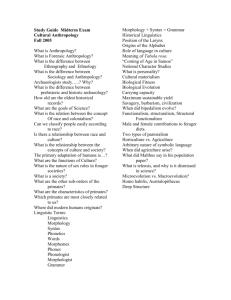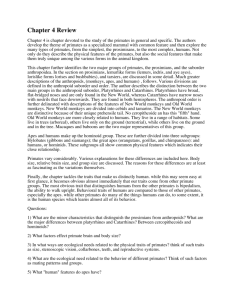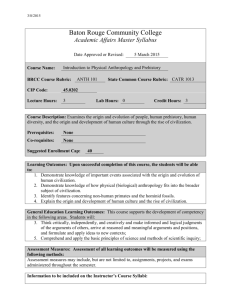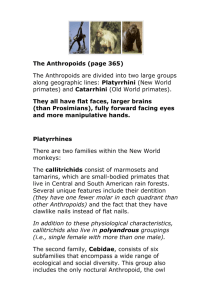The Living Primates LECTURE NOTES
advertisement
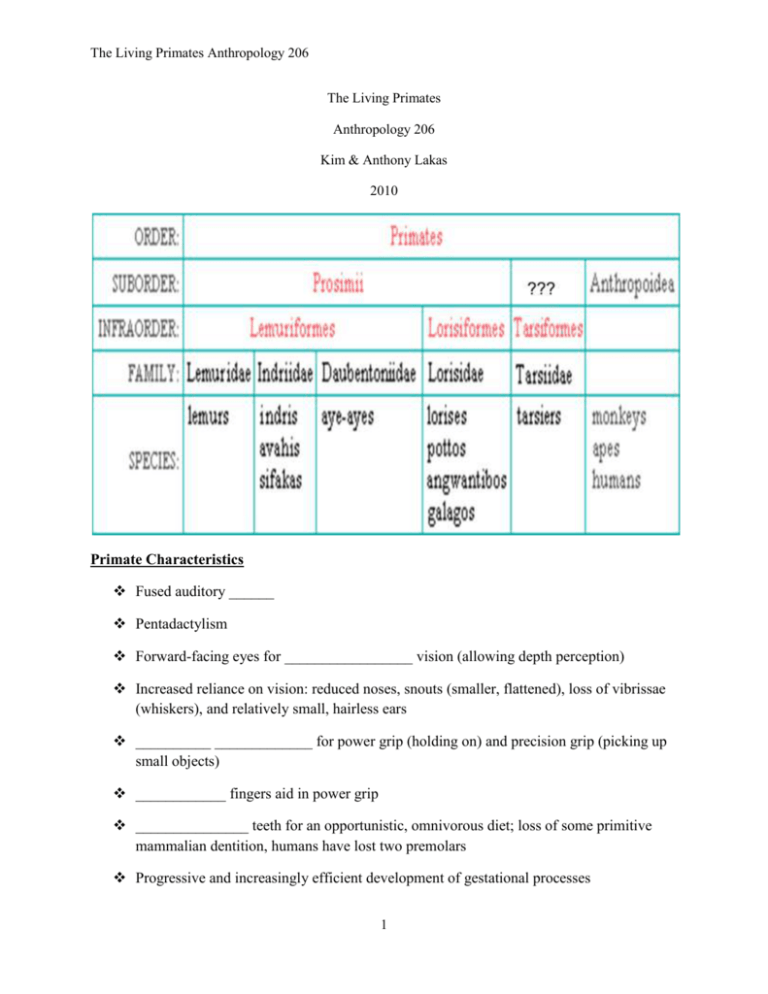
The Living Primates Anthropology 206 The Living Primates Anthropology 206 Kim & Anthony Lakas 2010 Primate Characteristics Fused auditory ______ Pentadactylism Forward-facing eyes for _________________ vision (allowing depth perception) Increased reliance on vision: reduced noses, snouts (smaller, flattened), loss of vibrissae (whiskers), and relatively small, hairless ears __________ _____________ for power grip (holding on) and precision grip (picking up small objects) ____________ fingers aid in power grip _______________ teeth for an opportunistic, omnivorous diet; loss of some primitive mammalian dentition, humans have lost two premolars Progressive and increasingly efficient development of gestational processes 1 The Living Primates Anthropology 206 Prolongation of postnatal life periods Reduced litter size—usually just _______ (allowing mobility with clinging young and more individual attention to young) Sub Order ______________ (also called Stepsirrhini) PROSIMIAN CHARACTERISTICS 1. More Primitive; Similar to the ___________ primate ancestors. 2. Greater reliance on the sense of smell – Large _______________ bulbs 3. Elongated snout 4. Bare Rhinarium (______) 5. Small body size. 6. Often lacking some typical primate characteristics such as color vision, bony eye cups, and claws instead of nails on some digits. 7. Usual mode of locomotion is vertical clinging and leaping (VCL). 8. Usually nocturnal. 9. Tapetum lucidum – producing “______ __________” 10. Often solitary. 11. Unfused frontal and mandibular symphesis 12. Lower incisors are ______________-forming a tooth comb. Helps with ___________ – eating gums and saps. Super Family _____________________ Family Lemuridae All creatures in family Lemuroidae Live on Island of ___________________ Multiple species of “true lemurs” Social _______________ – active at dawn and dusk Females are dominant Use scent marking Males and females involved in ‘stink fights’ 2 The Living Primates Anthropology 206 ______-like faces Omnivorous Super family LEMUROIDEA Family ______________________ These prosimians seem to be the most evolved, in the sense that they resemble____________ the most. _________ faced Indri: Largest lemur, ______’ Sifakas: meduium sized, locomotion usually leaping from tree to tree, running on ground Avahi smaller sized Super family LEMUROIDEA Family ______________________ the only species left in this family is the aye-aye, a solitary and nocturnal creature with unique features for a primate. Fills the _______________niche They have a _______on the third digit. Super family LORISOIDEA Family – __________________ Include _______ and ___________ lorises of Asia Potto and __________of Africa Most ‘primitive’ and widespread prosimians fore and hind limbs of equal length and very short tails feed on fruits and gum and slow-moving prey practice ‘________ ___________by moving extremely slowly through thick vegetation which hides them from predators Super family LORISOIDEA Family – ____________________ 3 The Living Primates Anthropology 206 In Superfamily Lorisoidea due to circulatory pattern in their brains Mouse and dwarf ‘lemurs’ of Madagascar 4 ________________ glands Frequent twin births Some species have bold markings on their faces, such as eye rings or nose stripes. The fur is often thick and woolly. Characterized by unusually long_____, large, thin, and membranous ears; They have large, forward-facing eyes, reflecting their nocturnal lifestyle, compact bodies, and long, delicate fingers with rounded tips. all ______________ and __________________. They generally forage on their own, but roost during the day in small social groups. Superfamily – taxonomic level debated. Mayr kept them separate Family - __________________ Like prosimians, they have a simple digestive tract, are nocturnal insectivores, have legs built for leaping (_______ _________), use grooming claws, and have an _______ ________. Like anthropoids, they have a complete________ ___________, a more advanced placenta, have a simple dry nose, and lack both a dental comb and the tapetum lucidum in their eyes. They also show a relatively larger brain than prosimians (mostly_______ _________). Unique fused ____________________ with expanded tarsus and calcanius. Molars with sharp pointy cusps. _____________________ also called Haplorhini The rhinarium is dry and hairy; nostrils are more rounded The upper lip is continuous and ___ attached to the gum; allows for more expressive face Eyes lack ______________ _________________ and do not reflect light Larger brain Reduced snout and less reliant on sense of smell Binocular and _____________________ vision 4 The Living Primates Anthropology 206 Color vision Trend towards longer arms than legs ___________ frontal and mandible Infraorder Platyrrhini – ________ World Monkey Outward facing, broad nostrils, flat, dry nose All but one genus, the owl monkeys, are diurnal _______a bony tube between eardrum and outer ear Large brains and highly developed vision Many exhibit complex social structures and family groups Some have special scent glands _______ ischial callosities (bare patches of skin on rump) Imperfect opposability of thumb and poorly developed finger grip The _____toe is large and strongly opposable Long, well developed tail, _____________________in some groups Some groups are fantastically arboreal, _________________________________ Auditory meatus is a ring Dental formula _____________ or _____________________. Superfamily:Ceboidea Families: Cebidae and ___________________ Genus: owl monkeys, organ grinder, spider monekys, howling monkeys and sakis Genus: __________________ and ________________. Callitrichida – tamarinds and marmosets Callitrichidae have claws, modified nails, that aid in climbing tree trunks Three ___________ and two ___________ (________) Pygmy marmoset is _______________monkey Some are polyandrous 5 The Living Primates Anthropology 206 Cebidae - capuchins,organ grinders, spider and howling monkeys, squirrel monkeys and sakis Cebidae have fingernails instead of claws, which aid in gripping Three __________ and three __________ (2-1-__-__) Owl monkey is only nocturnal monkey ________ do not have prehensile tails Infraorder: Catarrhini – _______ World Monkeys, Apes and ___________ Downward facing, narrow nostrils, short, _________nose Lack prominent whiskers (sensory vibrissae) ______ ________ between eardrum and outer ear present Large brain Diurnal Prominent sexual dimorphism in some: large canines, size, and coloration Complicated social structure Dental formulas __________ - sometimes _________________________, meaning that it sharpens the upper canine Well-developed ________ and _________thumb and/or big toe Short or no tail Many semi-terrestrial species Bracchiators Superfamily:Ceropithecoidea Family: Cercopithidae Subfamily: Cercopithicinae, _____________ Genus: baboons, vervets, macaques, gebralta Genus: __________, __________ Super family :Cercopithecoidea (_______ World Monkeys) 6 The Living Primates Anthropology 206 All have bilophodont molars (____ ________) Narrow thorax Non-prehensile tails Family: Cercopithidae Subfamily: ___________________ ___________ old world monkeys Macques in Asia Baboons, Gebralta in Arabia to South Africa Vervets in ___________ Some semi-terrestrial Subfamily: _________________ ____________ stomachs Extended intestinal tract for digesting low calorie leaves Colobus in _______ Languers in Asia Superfamily Hominoidea This superfamily contains humans and their close relatives, the apes. The first hominoids first appeared about 25 million years ago. Present-day hominoids are characterized by the absence of _______ and by rather ___________ rounded molars. This means that hominoid molars are less specialized than other primates. Bipedal Large brain Large size 7 The Living Primates Anthropology 206 Long arms Long curved fingers Very stable elbow joint Relatively spherical head of________ and open _______ allows for wide shoulder rotation High limb mobility Long and robust ________ Bony broad sternum Broad pelvis No tail __________ ____________molars Family Hylobatidae - This family contains the gibbons and siamangs. They are the smallest and most numerous of the apes, (______ _________). Because of their size hylobatids are sometimes referred to as lesser apes. Long forearms and arms, relative to body size __________ _____________, or bare skin on rumps The only hominoid that does not build ________ ________/ Omnivorous, but eats mostly fruit Territorial Live in monogamous pairs Some have enlarged throat sacs used when calling Largest canines of the apes Found only in the tropical forests of Southeast Asia Large brain and eye orbits Arm and shoulder girdle built for _________ Highly arboreal 8 The Living Primates Anthropology 206 _____ Chromosomes Minimal dimorphism Adolescents driven out Genus: Hylobates 10 + species (gibbons) Multi colored 48 chromosomes Genus: Symphalangus Larger Black 46 chromosomes Siamangs SuperFamily Hominidea Larger brain Complex social behaviors, including complex ______________ Larger body size Mostly terrestrial, only ______________ are fully arboreal Sexual dimorphism Opposable ________ and big______, except in humans, whose big toes are not opposable All digits have ________________ nails Lack ischial callosities Skeletal differences from other primates related to their upright/semiupright posture Birth of a single young 9 The Living Primates Anthropology 206 Family: Pongo Species: ____________________ Solitary _________ __________ (males approx 150 pounds and females approx 80 pounds) Single male, multiple females Overlapping territories Completion of males adolescence inhibited by adult male Diurnal Frugivorous _________________ clambering, bimanual suspension, fist walking Found in Asia on the islands of __________ and ________ Family: Panidae African apes 48 chromosomes Gorilla gorilla: males approx 300 pounds, females approx 150 pounds; ________ living ape Single male,_________ female bands Omnivorous: fruit, leaves, insects incidentally Pan troglodytes: common chimp Diet: fruit, leaves, some hunting Multiple male/multiple female bands Territorial Dominance hierarchies/aggression Pan paniscus: bonobo (pygmy chimp) 10 The Living Primates Anthropology 206 Multiple male/multiple female bands Affection/sexuality 11
